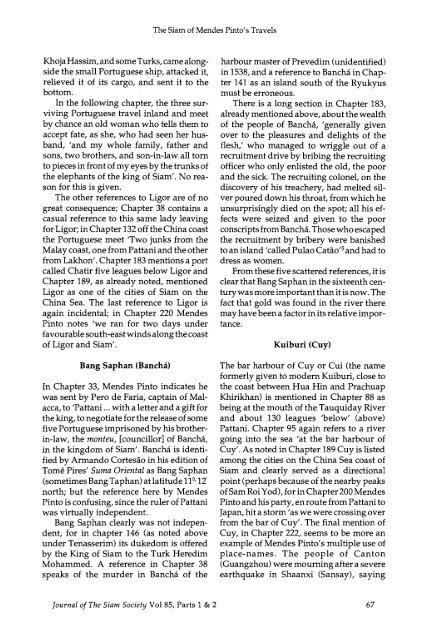The Journal of the Siam Society Vol. LXXXV, Part 1-2, 1997 - Khamkoo
The Journal of the Siam Society Vol. LXXXV, Part 1-2, 1997 - Khamkoo
The Journal of the Siam Society Vol. LXXXV, Part 1-2, 1997 - Khamkoo
You also want an ePaper? Increase the reach of your titles
YUMPU automatically turns print PDFs into web optimized ePapers that Google loves.
<strong>The</strong> <strong>Siam</strong> <strong>of</strong> Mendes Pinto's Travels<br />
Khoja Hassim, and some Turks, came alongside<br />
<strong>the</strong> small Portuguese ship, attacked it,<br />
relieved it <strong>of</strong> its cargo, and sent it to <strong>the</strong><br />
bottom.<br />
In <strong>the</strong> following chapter, <strong>the</strong> three surviving<br />
Portuguese travel inland and meet<br />
by chance an old woman who tells <strong>the</strong>m to<br />
accept fate, as she, who had seen her husband,<br />
'and my whole family, fa<strong>the</strong>r and<br />
sons, two bro<strong>the</strong>rs, and son-in-law all torn<br />
to pieces in front <strong>of</strong> my eyes by <strong>the</strong> trunks <strong>of</strong><br />
<strong>the</strong> elephants <strong>of</strong> <strong>the</strong> king <strong>of</strong> <strong>Siam</strong>'. No reason<br />
for this is given.<br />
<strong>The</strong> o<strong>the</strong>r references to Ligor are <strong>of</strong> no<br />
great consequence; Chapter 38 contains a<br />
casual reference to this same lady leaving<br />
for Ligor; in Chapter 132 <strong>of</strong>f <strong>the</strong> China coast<br />
<strong>the</strong> Portuguese meet 'Two junks from <strong>the</strong><br />
Malay coast, one from Pattani and <strong>the</strong> o<strong>the</strong>r<br />
from Lakhon'. Chapter 183 mentions a port<br />
called Chatir five leagues below Ligor and<br />
Chapter 189, as already noted, mentioned<br />
Ligor as one <strong>of</strong> <strong>the</strong> cities <strong>of</strong> <strong>Siam</strong> on <strong>the</strong><br />
China Sea. <strong>The</strong> last reference to Ligor is<br />
again incidental; in Chapter 220 Mendes<br />
Pinto notes 'we ran for two days under<br />
favourable south-east winds along <strong>the</strong> coast<br />
<strong>of</strong> Ligor and <strong>Siam</strong>'.<br />
Bang Saphan (Bancha)<br />
In Chapter 33, Mendes Pinto indicates he<br />
was sent by Pero de Faria, captain <strong>of</strong> Malacca,<br />
to 'Pattani ... with a letter and a gift for<br />
<strong>the</strong> king, to negotiate for <strong>the</strong> release <strong>of</strong> some<br />
five Portuguese imprisoned by his bro<strong>the</strong>rin-law,<br />
<strong>the</strong> monteu, [councillor] <strong>of</strong> Bancha,<br />
in <strong>the</strong> kingdom <strong>of</strong> <strong>Siam</strong>'. Bancha is identified<br />
by Armando Cortesao in his edition <strong>of</strong><br />
Tome Pires' Suma Oriental as Bang Saphan<br />
(sometimes Bang Tap han) at latitude 11 °· 12'<br />
north; but <strong>the</strong> reference here by Mendes<br />
Pinto is confusing, since <strong>the</strong> ruler <strong>of</strong> Pattani<br />
was virtually independent.<br />
Bang Saphan clearly was not independent,<br />
for in chapter 146 (as noted above<br />
under Tenasserim) its dukedom is <strong>of</strong>fered<br />
by <strong>the</strong> King <strong>of</strong> <strong>Siam</strong> to <strong>the</strong> Turk Heredim<br />
Mohammed. A reference in Chapter 38<br />
speaks <strong>of</strong> <strong>the</strong> murder in Bancha <strong>of</strong> <strong>the</strong><br />
harbour master <strong>of</strong> Prevedim (unidentified)<br />
in 1538, and a reference to Bancha in Chapter<br />
141 as an island south <strong>of</strong> <strong>the</strong> Ryukyus<br />
must be erroneous.<br />
<strong>The</strong>re is a long section in Chapter 183,<br />
already mentioned above, about <strong>the</strong> wealth<br />
<strong>of</strong> <strong>the</strong> people <strong>of</strong> Bancha, 'generally given<br />
over to <strong>the</strong> pleasures and delights <strong>of</strong> <strong>the</strong><br />
flesh,' who managed to wriggle out <strong>of</strong> a<br />
recruitment drive by bribing <strong>the</strong> recruiting<br />
<strong>of</strong>ficer who only enlisted <strong>the</strong> old, <strong>the</strong> poor<br />
and <strong>the</strong> sick. <strong>The</strong> recruiting colonel, on <strong>the</strong><br />
discovery <strong>of</strong> his treachery, had melted silver<br />
poured down his throat, from which he<br />
unsurprisingly died on <strong>the</strong> spot; all his effects<br />
were seized and given to <strong>the</strong> poor<br />
conscripts from Bancha. Those who escaped<br />
<strong>the</strong> recruitment by bribery were banished<br />
to an island 'called Pulao Catao'5 and had to<br />
dress as women.<br />
From <strong>the</strong>se five scattered references, it is<br />
clear that Bang Sap han in <strong>the</strong> sixteenth century<br />
was more important than it is now. <strong>The</strong><br />
fact that gold was found in <strong>the</strong> river <strong>the</strong>re<br />
may have been a factor in its relative importance.<br />
Kuiburi (Cuy)<br />
<strong>The</strong> bar harbour <strong>of</strong> Cuy or Cui (<strong>the</strong> name<br />
formerly given to modern Kuiburi, close to<br />
<strong>the</strong> coast between Hua Hin and Prachuap<br />
Khirikhan) is mentioned in Chapter 88 as<br />
being at <strong>the</strong> mouth <strong>of</strong> <strong>the</strong> Tauquiday River<br />
and about 130 leagues 'below' (above)<br />
Pattani. Chapter 95 again refers to a river<br />
going into <strong>the</strong> sea 'at <strong>the</strong> bar harbour <strong>of</strong><br />
Cuy'. As noted in Chapter 189 Cuy is listed<br />
among <strong>the</strong> cities on <strong>the</strong> China Sea coast <strong>of</strong><br />
<strong>Siam</strong> and clearly served as a directional<br />
point (perhaps because <strong>of</strong> <strong>the</strong> nearby peaks<br />
<strong>of</strong> Sam Roi Yod), for in Chapter 200 Mendes<br />
Pinto and his party, en route from Pattani to<br />
Japan, hit a storm 'as we were crossing over<br />
from <strong>the</strong> bar <strong>of</strong> Cuy'. <strong>The</strong> final mention <strong>of</strong><br />
Cuy, in Chapter 222, seems to be more an<br />
example <strong>of</strong> Mendes Pinto's multiple use <strong>of</strong><br />
place-names. <strong>The</strong> people <strong>of</strong> Canton<br />
(Guangzhou) were mourning after a severe<br />
earthquake in Shaanxi (Sansay), saying<br />
<strong>Journal</strong> <strong>of</strong> <strong>The</strong> <strong>Siam</strong> <strong>Society</strong> <strong>Vol</strong>85, <strong>Part</strong>s 1 & 2<br />
67

















